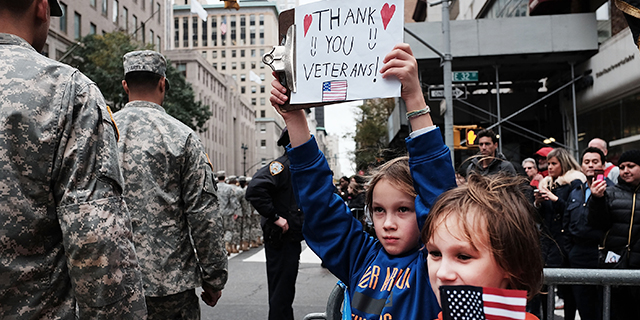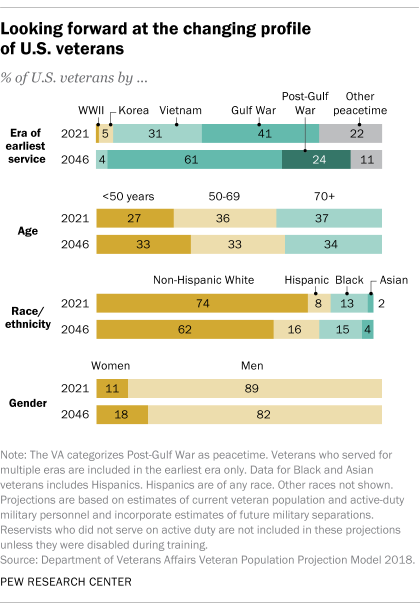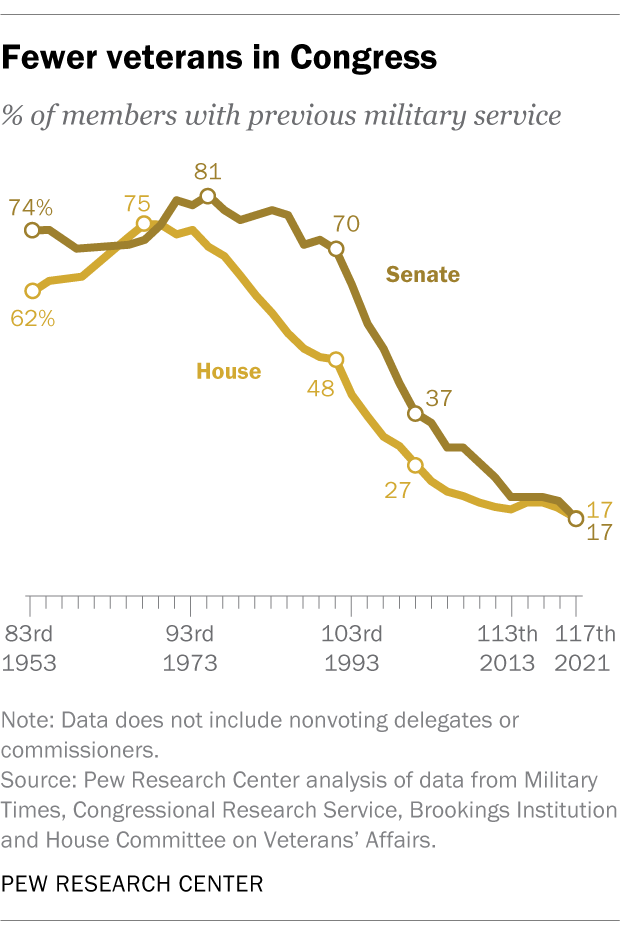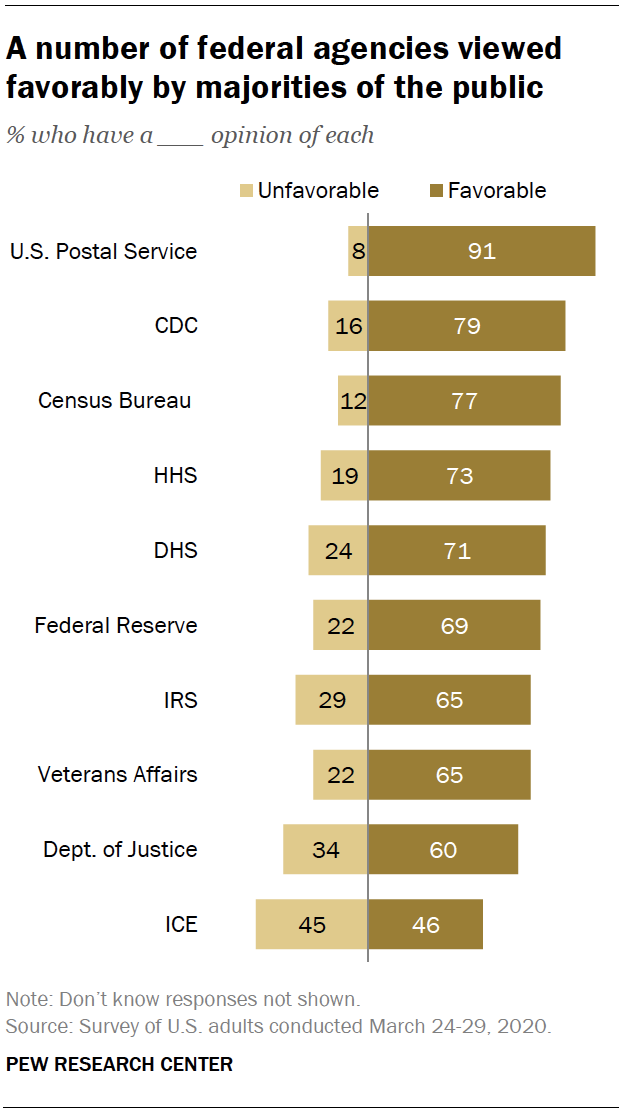How Many Members Have Had Prior Military Service?

At that place are around xix one thousand thousand U.South. veterans as of this year, according to data from the Section of Veterans Diplomacy, representing less than 10% of the total U.S. adult population. Here are key facts from the VA, the U.S. Demography Bureau and other sources about those who take served in the war machine and how this population is changing.
As U.S. demographics keep to shift, so does the makeup of the American veteran population. Pew Research Center has analyzed some of these changes using information from the Department of Veterans Diplomacy, the U.S. Census Bureau, the Department of Defense, Center surveys and other news reports. The 2021 and 2046 estimates of the veteran population come from projections published by the VA in 2018.

Gulf War-era veterans now account for the largest share of all U.S. veterans, having surpassed Vietnam-era veterans in 2016, according to the VA's 2018 population model estimates. VA estimates for 2021 betoken there are 5.ix million American veterans who served during the Vietnam era and 7.8 million who served in the Gulf War era, which spans from August 1990 through the nowadays. In that location are as well around 240,000 Earth State of war II veterans and most 933,000 who served during the Korean conflict, the VA estimates. Some veterans served through multiple eras but are counted only in their earliest era. Roughly iii-quarters (78%) of veterans in 2021 served during wartime, and 22% served during peacetime. (Veterans with wartime and peacetime service are only counted in wartime.)
The share of the U.South. population with armed forces experience is declining. In 2018, about 7% of U.S. adults were veterans, downward from 18% in 1980, co-ordinate to the Census Agency. This drib coincides with decreases in active-duty personnel. Over the past half-century, the number of people on active duty has dropped significantly, from iii.v one thousand thousand in 1968, during the military draft era, to about 1.4 meg (or less than 1% of all U.Southward. adults) in today's all-volunteer strength. The draft concluded in 1973.
VA projections advise the number of living veterans will go on to decline over the next 25 years. Past 2046, the department estimates there will be around 12.5 million veterans, a decrease of about 35% from current numbers. Past that fourth dimension, Gulf War-era veterans are projected to make upwardly a majority of those who served, and well-nigh veterans who served in the Vietnam era or earlier will have died.
The demographic contour of veterans is expected to change in the next quarter century. Currently, about nine-in-10 veterans (89%) are men, while near ane-in-ten (xi%) are women, co-ordinate to the VA'southward 2021 population model estimates. Past 2046, the share of female veterans is expected to increment to about 18%. The number of female veterans is also projected to increase slightly, from around 2 million in 2021 to approximately 2.2 million in 2046. The number of male veterans, on the other hand, is projected to drop from nearly 17 million in 2021 to around 10.3 one thousand thousand in 2046.
As with trends in the U.S. population overall, the veteran population is expected to go more racially and ethnically diverse. Between 2021 and 2046, the share of veterans who are not-Hispanic White is expected to drop from 74% to 62%. The share of veterans who are Hispanic is expected to double from 8% to 16%, while the share who are Black is expected to increment slightly from 13% to 15%.
Projections likewise betoken that the veteran population will become slightly younger, with 33% of veterans being younger than 50 in 2046 compared with 27% in 2021, fifty-fifty equally the overall U.Due south. population continues to age. The share of veterans ages 50 to 69 is expected to compress from 36% to 33%, while the share of those seventy and older is predicted to be around a tertiary of the total (34%) by 2046, slightly lower than the current share (37%).

Fewer members of Congress have prior military experience than in the past. Every bit the share of Americans who are veterans has declined, so has the share of legislators who have previously served in the military. In the current Congress, 17% of lawmakers in both houses had prior military service, down drastically from just a few decades ago.
The share of senators who are veterans reached a mail-Korean War peak of 81% in 1975, while the share amid House members peaked in 1967 at 75%. Still, in contempo elections, both Democrats and Republicans have made special efforts to recruit veterans for congressional contests, and the newly elected freshman form includes 15 such lawmakers.

The Department of Veterans Affairs receives a relatively low favorability rating compared with other authorities agencies. The VA received the third-lowest rating among ten agencies and departments in a Pew Research Centre survey last jump. Roughly ii-thirds of U.Southward. adults (65%) had a favorable view of the VA, and 22% expressed an unfavorable view. As with many of the agencies and departments in the survey, there were partisan differences in approval. Republicans and Republican-leaning independents expressed higher favorability for the VA (72%) than Democrats and Autonomous leaners (61%).
A 2019 survey plant veterans themselves had mixed feelings near the bureau: 9% of veterans said the department was doing an excellent job meeting the needs of military veterans; 37% said the VA was doing a skilful job. About half said it was doing just a fair (37%) or poor (15%) job.
Americans continue to see veterans' services equally an important priority. In a March 2019 survey, a 72% majority of U.Southward. adults (and identical 72% shares of Republicans and Democrats) said that if they were making the federal budget, they would increase spending for veterans' benefits and services – the highest share of all 13 programme areas included in the survey, except for education (likewise 72%), and the second-highest level of support for increased spending on veterans services since the Center commencement asked the question in 2001.
Source: https://www.pewresearch.org/fact-tank/2021/04/05/the-changing-face-of-americas-veteran-population/
Posted by: lukasikracrought.blogspot.com


0 Response to "How Many Members Have Had Prior Military Service?"
Post a Comment